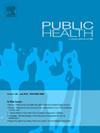全因死亡率和心血管疾病的社会经济梯度和不平等:使用韩国nhanes -死亡率关联数据的回顾性队列研究
IF 3.9
3区 医学
Q1 PUBLIC, ENVIRONMENTAL & OCCUPATIONAL HEALTH
引用次数: 0
摘要
韩国经济的快速增长为研究社会经济地位(SES)如何影响新兴高收入亚洲国家的死亡率和心血管疾病(CVD)风险提供了有价值的背景。本研究的目的是在普通人群和2型糖尿病(T2DM)亚组中检查这些相关性。研究设计回顾性队列研究。方法采用韩国国家健康与营养调查(KNHANES)中与死亡记录相关的数据。2011-2020年KNHANES队列共纳入48190名参与者,包括6382名T2DM患者,并随访至死亡、心血管事件(心肌梗死或缺血性卒中)或研究终点。结果与收入最高的五分之一组相比,收入最低的五分之一组的参与者死亡率(风险比[HR]: 1.44, 95% CI: 1.19-1.76)和心血管疾病(风险比:1.35,95% CI: 1.05-1.74)的风险更高。失业个体的死亡风险高于就业个体(HR: 1.34, 95% CI: 1.19 ~ 1.51)。无屋者的死亡风险也高于多屋者(HR: 1.46, 95% CI: 1.20-1.77)。与大学毕业生相比,小学教育程度或更低的参与者死亡率(HR: 1.59, 95% CI: 1.32-1.93)和心血管疾病(HR: 1.71, 95% CI: 1.31-2.24)的风险更高。在T2DM患者中,失业(HR: 1.43, 95% CI: 1.16-1.77)和低教育(HR: 1.53, 95% CI: 1.07-2.17)与较高的死亡率相关。结论:低社会经济地位与死亡和心血管疾病风险增加有显著关联。在T2DM人群的死亡率结果中也观察到类似的关联。本文章由计算机程序翻译,如有差异,请以英文原文为准。

Socioeconomic gradients and inequalities in all-cause mortality and cardiovascular diseases: A retrospective cohort study using Korean NHANES-mortality linkage data
Objectives
Rapid economic growth in South Korea provides a valuable context for investigating how socioeconomic status (SES) impacts mortality and cardiovascular disease (CVD) risk in an emerging high-income Asian country. The objective of this study was to examine these associations in a general population and a subgroup with type 2 diabetes mellitus (T2DM).
Study design
Retrospective cohort study.
Methods
Data from the Korea National Health and Nutrition Examination Survey (KNHANES) linked to mortality records was used. A total of 48,190 participants including 6,382 patients with T2DM from the 2011–2020 KNHANES cohort were included and followed until death, a cardiovascular event (myocardial infarction or ischemic stroke), or the study endpoint.
Results
Participants in the lowest income quintile had higher risks of mortality (Hazard ratio [HR]: 1.44, 95 % CI: 1.19–1.76) and CVD (HR: 1.35, 95 % CI: 1.05–1.74) compared to the highest quintile. Unemployed individuals had a higher mortality risk (HR: 1.34, 95 % CI: 1.19–1.51) than employed ones. Non-homeowners also had a higher mortality risk (HR: 1.46, 95 % CI: 1.20–1.77) than multi-homeowners. Participants with elementary school education or less had higher risks of mortality (HR: 1.59, 95 % CI: 1.32–1.93) and CVD (HR: 1.71, 95 % CI: 1.31–2.24) compared to college graduates. Among those with T2DM, unemployment (HR: 1.43, 95 % CI: 1.16–1.77) and low education (HR: 1.53, 95 % CI: 1.07–2.17) were associated with higher mortality.
Conclusions
This analysis revealed significant associations of low SES with increased risks of mortality and CVD. Similar associations were observed in T2DM population for mortality outcomes.
求助全文
通过发布文献求助,成功后即可免费获取论文全文。
去求助
来源期刊

Public Health
医学-公共卫生、环境卫生与职业卫生
CiteScore
7.60
自引率
0.00%
发文量
280
审稿时长
37 days
期刊介绍:
Public Health is an international, multidisciplinary peer-reviewed journal. It publishes original papers, reviews and short reports on all aspects of the science, philosophy, and practice of public health.
 求助内容:
求助内容: 应助结果提醒方式:
应助结果提醒方式:


